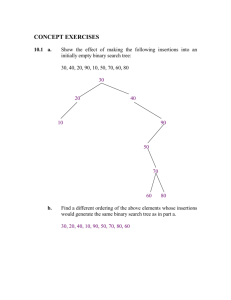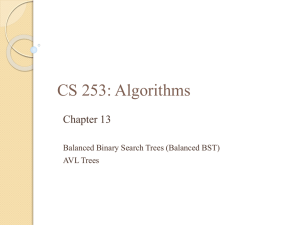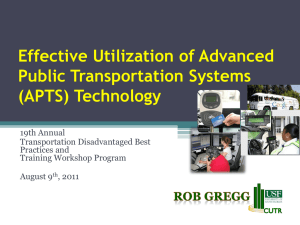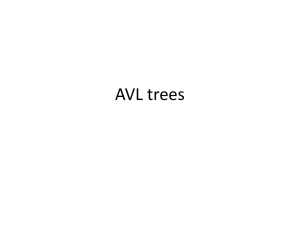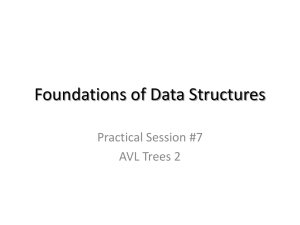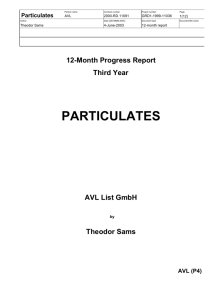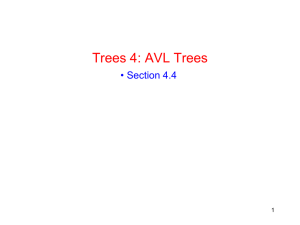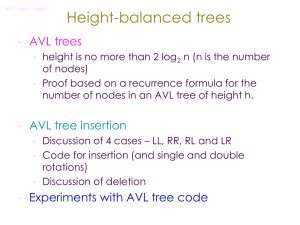UNCONFIRMED MINUTES OF THE
advertisement
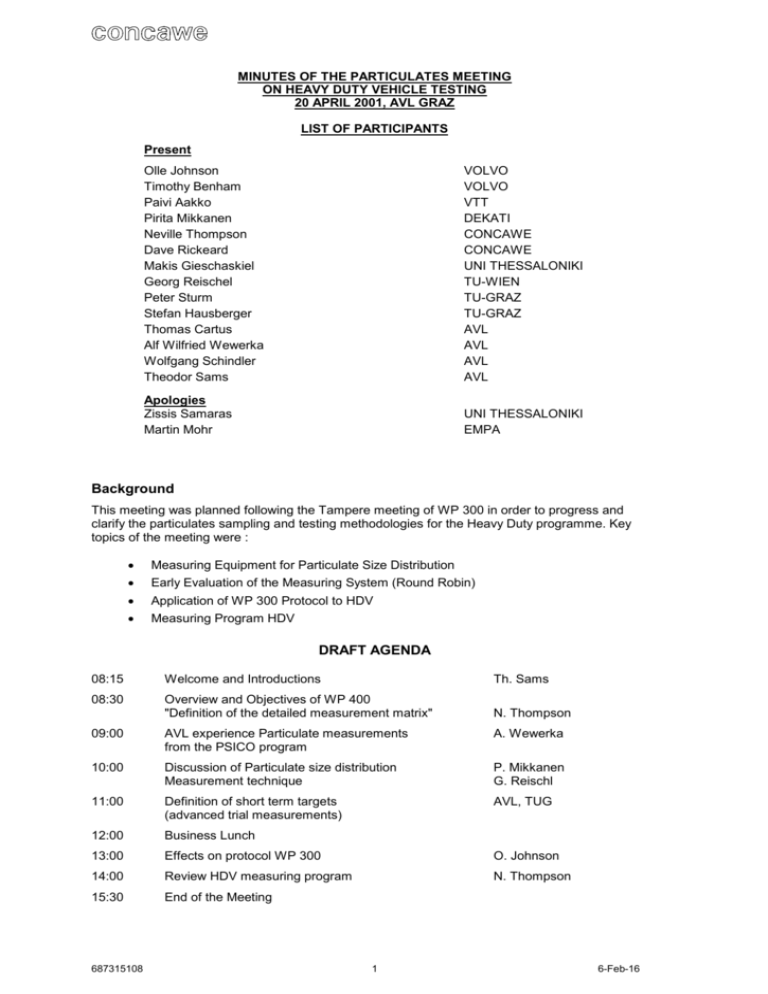
MINUTES OF THE PARTICULATES MEETING ON HEAVY DUTY VEHICLE TESTING 20 APRIL 2001, AVL GRAZ LIST OF PARTICIPANTS Present Olle Johnson Timothy Benham Paivi Aakko Pirita Mikkanen Neville Thompson Dave Rickeard Makis Gieschaskiel Georg Reischel Peter Sturm Stefan Hausberger Thomas Cartus Alf Wilfried Wewerka Wolfgang Schindler Theodor Sams VOLVO VOLVO VTT DEKATI CONCAWE CONCAWE UNI THESSALONIKI TU-WIEN TU-GRAZ TU-GRAZ AVL AVL AVL AVL Apologies Zissis Samaras Martin Mohr UNI THESSALONIKI EMPA Background This meeting was planned following the Tampere meeting of WP 300 in order to progress and clarify the particulates sampling and testing methodologies for the Heavy Duty programme. Key topics of the meeting were : Measuring Equipment for Particulate Size Distribution Early Evaluation of the Measuring System (Round Robin) Application of WP 300 Protocol to HDV Measuring Program HDV DRAFT AGENDA 08:15 Welcome and Introductions Th. Sams 08:30 Overview and Objectives of WP 400 "Definition of the detailed measurement matrix" N. Thompson 09:00 AVL experience Particulate measurements from the PSICO program A. Wewerka 10:00 Discussion of Particulate size distribution Measurement technique P. Mikkanen G. Reischl 11:00 Definition of short term targets (advanced trial measurements) AVL, TUG 12:00 Business Lunch 13:00 Effects on protocol WP 300 O. Johnson 14:00 Review HDV measuring program N. Thompson 15:30 End of the Meeting 687315108 1 6-Feb-16 1. Welcome and Introductions Theodor Sams opened the meeting and introduced the participants. He presented an overview on the meeting objectives (see above) and the agenda was agreed. N. Thompson agreed to record the minutes. 2. Overview and Objectives of WP 400 "Definition of the detailed measurement matrix" N. Thompson gave an overview of the current status on the Particulates project, using his WP-400 presentation from the Tampere meeting, March 2001: WP 200 completed. Report on “Vehicle exhaust particulates characterisation, properties, instrumentation and sampling requirements” issued WP 300 work in progress evaluating the proposed sampling and testing protocol on light duty diesel vehicles Dekati dilution system with “wet” and “dry” branches Tests so far carried out by EMPA, LAT, IFP and AEAT - Repeatable measurements on accumulation mode particles - Nucleation mode particles highly sensitive to sampling and testing conditions Further tests on light duty vehicles underway in several labs Target to produce final WP 300 test protocol by July WP 400’s task is to refine the definition of the overall test matrix for the measurement campaign. A first draft of the WP 400 report, Deliverable-5 had recently been issued and would be reviewed later. Currently the plans for the HD measurement campaign include tests to be carried out at Volvo, MTC, AVL, TUG and VTT. S. Hausberger presented an overview of the Heavy Duty measurement programme in ARTEMIS (ARTEMIS Deliverable 10). The ARTEMIS programme includes both steady state and transient tests on a range of vehicles and engines. He presented results showing that there could be large increases in emissions between on-cycle and off-cycle steady state conditions (NOx up to 2*, PM up to 10*). This highlighted the importance of including transient tests and off-cycle conditions. He said that he needed to study the initial ARTEMIS results before recommending the final HDV test cycles for PARTICULATES. Action: 3. S Hausberger to advise on HD test cycles AVL experience on Particulate measurements from the PSICO program AVL presented their experience from the PSICO programme (Attachment 1). This programme is also looking into particulate size and number measurement, advanced engine technologies and measurement system optimisation. AVL are involved in measurement techniques, ECU optimisation for control of particulates and after-treatment. Measurement techniques currently available at AVL include the AVL smart sampler and dilution tunnel, DDMPS (Dual Differential Mobility Particle Spectrometer), TDMPS (Transient DMPS), ELPI (Electrical Low Pressure Impactor) and AEM (Analytical Transmission Electron Microscopy). The DDMPS offers a much higher sampling rate than the SMPS. The new TDMPS, which is effectively multiple SMPSs configured to work together, provides rapid response time and is 687315108 2 6-Feb-16 able to measure particle size distributions across transient drive cycles. Both require detailed knowledge and training to operate. The ELPI, selected by Particulates for its transient capability, is easier to use, but interpretation of results can be difficult and it’s range is currently limited to particle sizes above ca. 30 nm min. AVL have observed high particulate number counts with the ELPI in size ranges above 300 nm which do not correlate with DDMPS. Nucleation mode particles are observed in the AVL dilution set-up and there is little effect of secondary dilution ratio. Nucleation mode particle numbers were reduced when a thermodenuder was operated at 215 - 245 deg C. The numbers of particles in size ranges up to 100 nm were also reduced – this was believed to be due to agglomeration to higher size range as volatiles are removed. Sampling location is important as agglomeration occurs in the exhaust pipe and sample lines as well as due to the thermodenuder. Residence time needs to be carefully standardised. AEM results showed particulates containing carbon and sulphur at < 20 nm. General understanding is that carbonaceous particles are produced by the engine, mainly under high load operation. Nucleation mode particles are believed to appear mainly under decelerations, by desorption from the walls of the exhaust. Nucleation mode particle production becomes more likely as carbonaceous particles are reduced. 4. Discussion of Particulate size distribution measurement techniques Pirita Mikkanen provided a summary of the current sampling and testing set-up proposed for use in Particulates. This involves the Dekati dilution system which provides accurate control of exhaust dilution conditions. The Particulates set-up includes a “wet” branch where total particle count can be measured (via DMA, CPC, DC) and a “dry” branch using a thermodenuder prior to an ELPI to provide size/number count without interference from the nucleation mode. Pirita explained the basis for the two dilution windows currently under investigation in Particulates. EMPA’s data on the influence of dilution conditions was reviewed (see M. Mohr presentation from the Thessaloniki meeting, Feb 2001). Considerable discussion ensued on selection of the optimal dilution conditions. Prof Reischl argued against the Particulates dilution approach as this “worst case” scenario can change the nature of the particles that are emitted. Pirita Mikannen argued that we need to select a high stable condition as we cannot expect to simulate all real world conditions at this stage. Dave Rickeard pointed out that we need to produce meaningful measurements as the modellers will eventually treat the data as real. Prof. Reischl recommended that exhaust gas sampling should be taken from the tailpipe and that dilution should be carried out in a way that does not change the exhaust aerosol emitted. He suggested that this can be achieved by dilution with warm dry gas just above exhaust gas temperature. 5. Definition of short term targets - advanced trial measurements – AVL, TUG The discussion was then focussed on how to move forward with the protocol for HD testing. Mr Schindler (AVL) expressed concern over the capability of the Dekati dilution system to handle the pulsating exhaust flow from HD engines. Others did not expect major problems. It was agreed that the Dekati system as proposed for Particulates has to be tested. It was also felt that the Particulates measurement system should be evaluated alongside the AVL/Reischl systems in order to provide a firm knowledge base for Particulates. TUG/AVL offered the possibility to carry out some preliminary work on an HD engine (linked to Artemis), which could be made available in September/October. This work could not be 687315108 3 6-Feb-16 completed in time to contribute to the WP300 protocol (due by end July) but would still provide a firmer foundation for Heavy Duty testing in WP-500. The following outline programme was agreed : Heavy Duty 12l, EURO-3 engine ESC + off-cycle steady states + ETC Measurements (to be taken from the tailpipe, not engine out) A) Particulates measurement and dilution system, Dekati diluter cold dilution, 2 windows hot dilution (> 200 deg C) B) AVL / Reischl measurement and dilution system C) AVL / Reischl measurement system with Dekati diluter D) Other dilution systems : CVS, AVL partial flow diluter Fuels Two fuels at different sulphur levels should be tested to clarify sensitivities to sampling and testing conditions. Common lube to be used, preferably the same batch selected for the main programme. Action: 6. S. Hausberger, Th. Sams, N. Thompson to develop the detailed plan for the above pre-test Effects on protocol WP 300 O. Johnson presented the first draft of the WP 300 Heavy Duty test protocol. Standard bench engine tests should be according to 1999/96/EC, i.e. ESC and ETC tests. It was agreed that the relevant legislative cycles should be included for each engine as a minimum. It was thought to be too early to include the Worldwide Harmonised Heavy Duty test cycle. Further off-cycle conditions and real world transient cycles for vehicles and city buses still to be defined. Action: S Hausberger, Paivi Aakko Some finer technical details were discussed, including location of exhaust gas sampling points, length of exhaust pipe (typical length – 4-5 m) and measurement of exhaust pipe wall temperature (should be monitored, but not cooled). Pirita Mikkannen described a system to help damp pressure fluctuations. Action: 7. Any further comments to be sent in to O. Johnson Review Heavy Duty measurement program (WP 500) The HD measurement programme was briefly reviewed based on the first draft of WP400, Deliverable 5 and the comments at the meeting. Further details on the tests to be carried out by each partner to be sent in to N. Thompson in order to finalise Deliverable 5 by May 1st. Deliverable 5 will however, remain a working document to be reviewed prior to the start of WP 500 testing. Volvo confirmed that they will now not include a Euro-0 engine. They will test Euro-1 and Euro-3 engines and the Euro-3 engine plus after-treatment. Fuels to be tested will include : 687315108 4 6-Feb-16 D1,D4,D5 for Euro-1; D2,D4,D5 for Euro 3; D5, possibly also D4 depending on budget, in the engine with after-treatment. TU-Graz plans were modified to include the early testing on the Euro-3 engine to be run in cooperation with AVL. To compensate resources, they will now test 2 HD vehicles rather than 3. VTT will try to include both LPG and CNG buses. Details of the AVL programme were further developed in a separate meeting of AVL/CONCAWE directly after this meeting. The SUV work was dropped in view of the additional HD work needed. The AVL programme should now include : Nominal 1l/cyl engine Euro-3 without after-treatment, no EGR Euro 4-5 with EGR and CRT Nominal 2l/cyl engine Euro-3 without after-treatment Euro 4-5 with SCR Fuels: Euro-3 engines : D2 to D5 Euro-4-5 engines with after-treatment, D3 to D5 Action: 687315108 All to forward any further comments on Deliverable 5 to N. Thompson N. Thompson to issue Deliverable 5 by May 1st. 5 6-Feb-16
